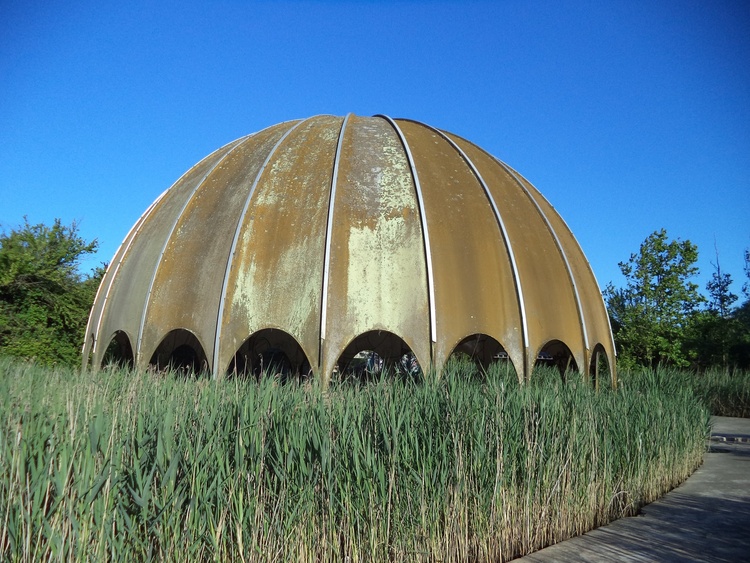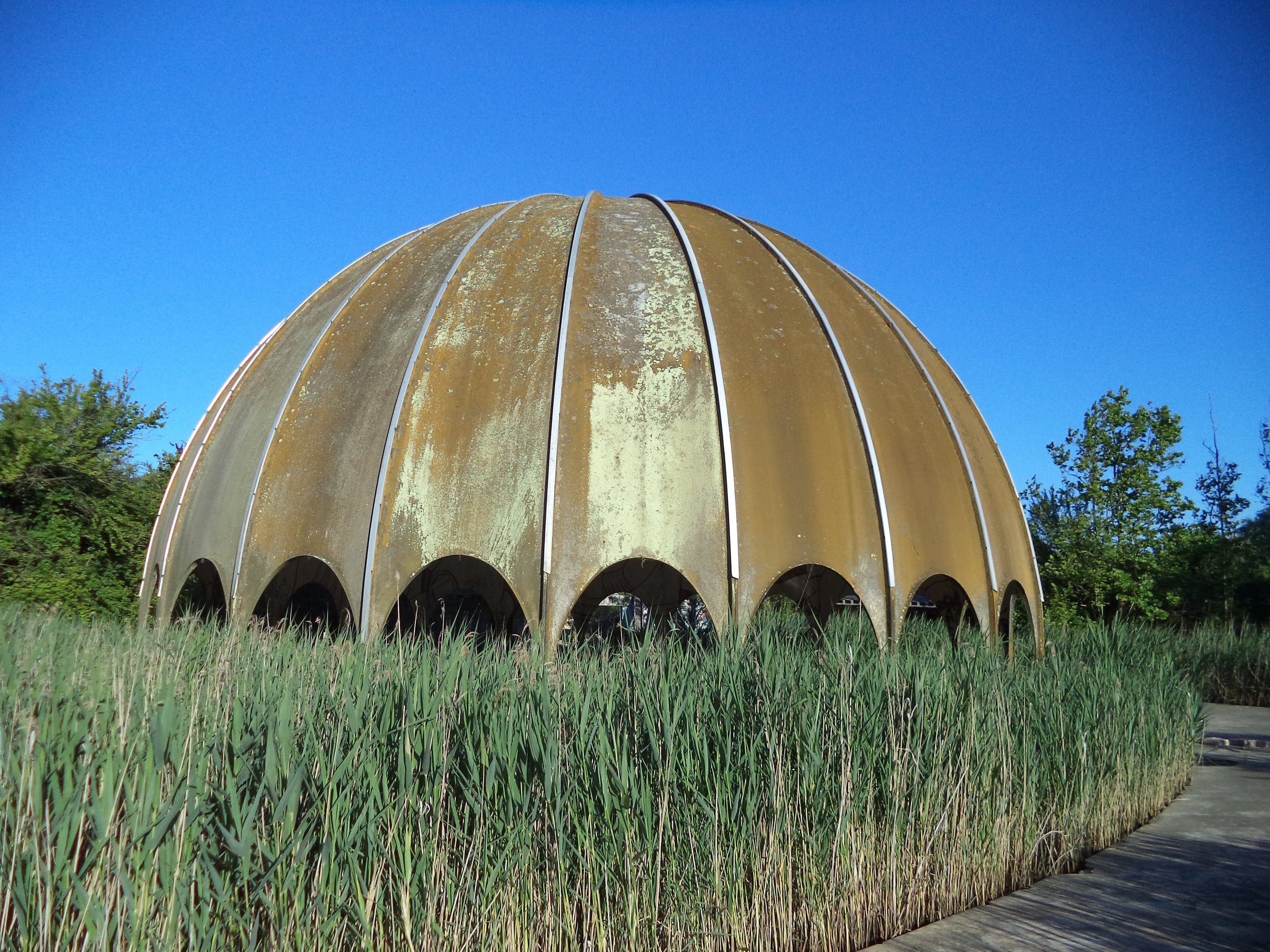Woodpecker Disco – Cervia, Emilia-Romagna
Woodpecker disco is a domed nightclub nestled in a pine forest near Cervia, in the northern Italian region of Emilia-Romagna.
The structure was designed by architect Filippo Monti and began operating as a club in the late 1960s.
It was considered one of the most popular clubs of the Adriatic Riviera until its closure in the mid-1970s following an electrical fire.
Abandoned since its closure, the dome now hosts night raves and illegal parties, and has become a hub for artists, including the mysterious Italian street artist known as “Blu”.
Metropoliz Museum of the Other and the Elsewhere (MAAM) – Rome, Lazio

An abandoned salami factory in the outskirts of Rome, this building has been revived as a collective art space and a home for refugees and squatters.
Since 2009, the former factory has housed 60 families from a variety of backgrounds, including impoverished Italians, Northern Africans, South Americans, and Roma and Sinti people.
The community of squatters had already begun painting murals on the walls when curator Giorgio de Finis discovered the site in 2011 and began organising events and performances there.
What became a collaboration between Mr de Finis and the factory’s 200 residents has led to murals, paintings, and installations made by more than 300 artists from around the world.
If you don’t plan on heading to Rome anytime soon, you can catch a glimpse into MAAM and the Italian Cultural Institute in Melbourne.
On Friday, April 20, the institute will host a Q&A session with Mr De Finis and Veronica Montanino, a Roman based artist with a studio that involves engaged public work with minorities.
Villa De Vecchi – Cortenova, Lombardy

Just east of Lake Como, nestled amongst the forested mountains of Cortenova, sits a haunted house.
Villa De Vecchi, also known as the “Red House”, was built between 1854 and 1857 as the summer residence of Count Felice De Vecchi.
For decades now, the once lavish building has been derelict, abandoned to total degradation.
According to one of the many legends associated with the villa, its decay began after the count found his wife and daughter brutally murdered.
However, it’s more commonly believed that the building was abandoned and fell into disrepair after the count’s death.
Nowadays, the building’s outer walls are covered with vines, while frescoes and tapestries on the interior have been damaged by humidity or vandalised.
Despite all natural and human efforts to bring about its demise, Villa De Vecchi persists.
An avalanche in 2002 wiped out all of the nearby houses, while the villa remained untouched.
Legend has it that a ghost lives in the villa and that it plays the piano every night.
The Grand Hotel Wildbad – Innichen, South Tyrol

Royalty and aristocrats have been utilising the five mineral springs in Innichen (San Candido) as thermal baths since the Middle Ages, although the first recorded spa is only mentioned in the 16th century.
The Grand Hotel Wildbad, which was built around the park’s famous thermal baths of San Candido, went into decline as the number of guests dwindled during wartime.
The hotel was auctioned off in around 1939, but abandoned over time, and all that remains is the crumbling shell of the building.
Grand Hotel Campo dei Fiori – Varese, Lombardy

Perched on top of a staggering mountain, The Grand Hotel Campo dei Fiori was established as a sumptuous cousin to the smaller Palace Hotel in Varese in 1910, when tourism in the northern Italian city was peaking.
The hotel endured two world wars, however after WWII, it began to struggle.
The hotel closed in 1968 and has remained frozen in time since.
In the 1980s, radio antennae were installed atop the roof of the historic building.
This marred the appearance of the old hotel, but leasing out the rooftop allowed the owners to pay for maintenance.
In 2016, the Grand Campo Hotel dei Fiori was sold to a private group owned by a former politician.
The group has not yet confirmed any plans for the former hotel.
Tourists can only view the building from the outside while hiking through the surrounding parklands.
Giuseppe Antonini Asylum – Limbiate, Lombardy

Walled off from the town of Limbiate, just outside Milan, stand the ruins of the Giuseppe Antonini, a psychiatric hospital whose rich history includes being the temporary home of Napoleon Bonaparte, the location of early experiments in electroconvulsive therapy, and the resting place of Italian fascist dictator Benito Mussolini’s illegitimate son.
Thanks to the Italian Mental Health Act of 1978 – also known as the Basaglia Law after the doctor who inspired its principles – the asylum was no longer legally allowed to operate and the property fell into disuse soon after.
Most of the structure is dilapidated nowadays.
Those few buildings that are still in use are occupied by a local high school and a much smaller, modern healthcare facility.
Risiera di San Sabba – Trieste, Friuli-Venezia Giulia

Located in the northern Italian city of Trieste, this former rice mill began production in 1898.
But in September 1943, the Risiera di San Sabba complex became a Nazi concentration camp, used for the detention and murder of political prisoners and Jews.
Many of the prisoners held at Risiera di San Sabba later went on to the concentration camp at Auschwitz-Birkenau.
Historians estimate that over 3,000 people were killed at the risiera itself, often by cremation and gassing.
After World War II, the rice mill did not return to business as usual, but became a centre for post-war refugees, taking in many ethnic Italians fleeing Yugoslavia in the 1950s.
In 1965, the Risiera di San Sabba was declared a national monument, and in 1975 was converted into a museum, which tourists can now visit.
Castle of Sammezzano – Leccio, Tuscany

Situated in a picturesque forest estate, not far from the Tuscan capital of Florence, sits the technicoloured Castle of Sammezzano.
The original castle was erected in around 1605 by the Spanish nobleman Ximenes of Aragon.
In the 19th century, Ferdinand Panciatichi Ximenes inherited the property and, between 1853 and 1889, he transformed it into one of the largest examples of Moorish Revival architecture.
The castle served as a luxury hotel following World War II, but eventually it was vacated and closed.
A committee dedicated to Ferdinand Panciatichi Ximenes d’Aragon was organised in 2012 in an attempt to restore and preserve the castle, which has 365 rooms, each with unique, Moorish decoration.
Ospedale Psichiatrico di Volterra – Volterra, Tuscany

Founded in 1888, the Ospedale Psichiatrico di Volterra in the Tuscan town of Volterra once housed up to 6,000 patients.
It closed in the 1970s, but the abandoned buildings and cemetery remains.
The hospital ruins are also known for the intriguing and disturbing mural created by inmate Oreste Fernando Nannetti, now partially destroyed by decades of exposure to the elements.
The cemetery of the hospital is also in ruins, with many of the former patients who were unclaimed, forgotten beneath the overgrown grass.
The Valley of the Mills – Sorrento, Campania

Nestled in a deep ravine between two towering cliffs, the Valley of the Mills, or Il Vallone dei Mulini, is a hidden gem that will transport you to another world.
Situated in the heart of Sorrento, just a stone’s throw from the central Piazza Tasso, this old abandoned flour mill was constructed around the 10th century.
The mill operated for a thousand years until around 1866 when the creation of Piazza Tasso isolated the mill from the sea, provoking a rise in the humidity, which soon forced the mill’s closure.
If you look closely enough, you will spot the adjacent sawmill and public washhouse through the dense mosaic of ancient stone and creeping vegetation.
Interestingly, the gorge now lends itself to a unique microclimate which promotes the growth of lush foliage.












